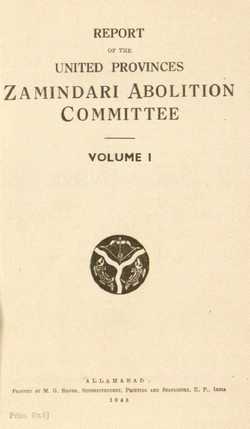The 1948 Report of the United Provinces Zamindari Abolition Committee offers a critical analysis of the land tenure system in colonial India. Focusing on the United Provinces (present-day Uttar Pradesh), the report exposes the deep-rooted economic and social inequalities fostered by the zamindari system. Established during British rule, this system positioned zamindars (landlords) as rent collectors, extracting revenue from tenant farmers while remitting a portion to the colonial government. The report meticulously dissects the system's detrimental effects, highlighting issues like population pressure on land, a skewed occupational distribution favouring agriculture, and the prevalence of uneconomical landholdings. These factors contributed to widespread rural indebtedness, hampered agricultural efficiency, and ultimately led to insufficient food production, jeopardising the well-being of the growing population.
The report delves into the historical evolution of land systems in the region. It contrasts the communal land management practices prevalent during the Hindu period with the more centralised control implemented under Muslim rule. However, the most significant shift came with the British Raj and the introduction of the zamindari system. This system concentrated landownership in the hands of a few, exacerbating socio-economic disparities.
Recognizing the urgency of reform, the committee meticulously examines existing land rights. It categorises these rights into proprietary holdings (zamindars and landowners), inferior proprietary rights (smaller landholders and tenants with occupancy rights), and precarious temporary cultivation rights. By studying agrarian reforms undertaken in other Indian provinces and various countries like those in Eastern and South-Eastern Europe, as well as collective farming models adopted in the USSR, Palestine, and Mexico, the report gathers valuable comparative insights.
The crux of the report lies in its compelling arguments for abolishing the zamindari system. The committee meticulously outlines the system's inefficiencies, its role in perpetuating social injustices, and the critical need for a more equitable land distribution. The report posits that eliminating intermediaries like zamindars will pave the way for improved agricultural productivity and empower tenant farmers, ultimately leading to better livelihoods.
The second part of the report presents a comprehensive roadmap for transitioning to a reformed agrarian structure. It proposes the abolishment of the zamindari system and the redistribution of land directly to cultivators. The report acknowledges the need for fair compensation to zamindars and explores various methods, including graded rates and considerations for specific categories like joint Hindu families and institutions. Furthermore, it outlines practical steps for land redistribution to ensure fairness and efficiency. Recognizing the challenges faced by farmers in the new system, the report recommends measures to provide crucial support, including access to credit, agricultural education, and improved infrastructure.
The 1948 Report of the United Provinces Zamindari Abolition Committee stands as a landmark document. It provides a scathing critique of the colonial land tenure system and proposes a transformative agenda for agrarian reform. By advocating for the abolition of the zamindari system and the redistribution of land, the report envisioned a future Indian agriculture marked by increased productivity, reduced poverty, and a more equitable social order in rural areas.


